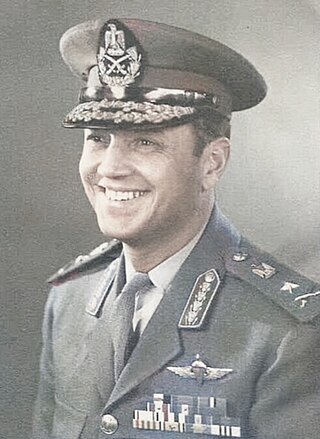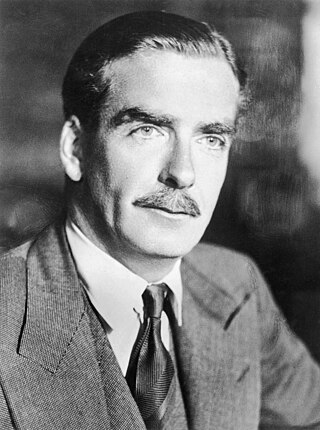Related Research Articles

Gamal Abdel Nasser Hussein was an Egyptian military officer and politician who served as the second president of Egypt from 1954 until his death in 1970. Nasser led the Egyptian revolution of 1952 and introduced far-reaching land reforms the following year. Following a 1954 attempt on his life by a Muslim Brotherhood member, he cracked down on the organization, put President Mohamed Naguib under house arrest and assumed executive office. He was formally elected president in June 1956.

The Suez Crisis also known as the Second Arab–Israeli War, the Tripartite Aggression in the Arab world and as the Sinai War in Israel, was a British–French–Israeli invasion of Egypt in 1956. Israel invaded on 29 October, having done so with the primary objective of re-opening the Straits of Tiran and the Gulf of Aqaba as the recent tightening of the eight-year-long Egyptian blockade further prevented Israeli passage. After issuing a joint ultimatum for a ceasefire, the United Kingdom and France joined the Israelis on 5 November, seeking to depose Egyptian president Gamal Abdel Nasser and regain control of the Suez Canal, which Nasser had earlier nationalised by transferring administrative control from the foreign-owned Suez Canal Company to Egypt's new government-owned Suez Canal Authority. Shortly after the invasion began, the three countries came under heavy political pressure from both the United States and the Soviet Union, as well as from the United Nations, eventually prompting their withdrawal from Egypt. Israel's four-month-long occupation of the Egyptian-occupied Gaza Strip and Egypt's Sinai Peninsula enabled it to attain freedom of navigation through the Straits of Tiran, but the Suez Canal was closed from October 1956 to March 1957.

The Free Officers were a group of revolutionary Egyptian nationalist officers in the Egyptian Armed Forces and Sudanese Armed Forces that instigated the Egyptian revolution of 1952. Initially started as a small rebellion military cell under Abdel Moneim Abdel Raouf, which included Gamal Abdel Nasser, Hussein Hamouda, Khaled Mohieddin, Kamal el-Din Hussein, Salah Nasr, Abdel Hakim Amer, and Saad Tawfik, it operated as a clandestine movement of junior officers who were veterans of the Palestine War of 1948-1949 as well as earlier nationalist uprisings in Egypt in the 1940s.

Middle East Command, later Middle East Land Forces, was a British Army Command established prior to the Second World War in Egypt. Its primary role was to command British land forces and co-ordinate with the relevant naval and air commands to defend British interests in the Middle East and eastern Mediterranean region.

Mohamed Abdel Hakim Amer, better known as Abdel Hakim Amer, was an Egyptian military officer and politician. Amer served in the 1948 Arab–Israeli War, and played a leading role in the military coup that overthrew King Farouk in 1952. After leading Egyptian forces in the 1956 Suez war, he was appointed Minister for Defense by President Gamal Abdel Nasser and was Egyptian Vice President between 1958 and 1965.

William Richard Higgins was a United States Marine Corps colonel who was captured in Lebanon in 1988 while serving on a United Nations (UN) peacekeeping mission. He was held hostage, tortured and eventually murdered by his captors.
Members of the Iraqi insurgency began taking foreign hostages in Iraq beginning in April 2004. Since then, in a dramatic instance of Islamist kidnapping they have taken captive more than 200 foreigners and thousands of Iraqis; among them, dozens of hostages were killed and others rescued or freed. In 2004, executions of captives were often filmed, and many were beheaded. However, the number of the recorded killings decreased significantly. Many hostages remain missing with no clue as to their whereabouts. The United States Department of State Hostage Working Group was organized by the U.S. Embassy, Baghdad, in the summer of 2004 to monitor foreign hostages in Iraq.

Field Marshal Ahmad Ismail Ali was an Egyptian senior military officer who was Egypt's minister of war during the Yom Kippur War of 1973. He is best known for his planning of the attack across the Suez Canal, code-named Operation Badr.
The Christian Peacemaker hostage crisis involved four human rights workers of Christian Peacemaker Teams (CPT) who were held hostage in Iraq from November 26, 2005 by the Swords of Righteousness Brigade. One hostage, Tom Fox, was killed, and the remaining three freed in a military operation on March 23, 2006.

Saad el-Din Mohamed el-Husseiny el-Shazly was an Egyptian military officer. He was Egypt's chief of staff during the Yom Kippur War. He is credited with the equipping and preparation of the Egyptian Armed Forces in the years prior to the successful capture of the Israeli Bar-Lev line at the start of the Yom Kippur War. He was dismissed from his post on 13 December 1973.
Colonel Cyril Banks MBE was a British engineer, company director, and politician. He was a Conservative Party representative, but his friendship with President Nasser and Egypt led him to sacrifice his career over the invasion of Suez.
The 1998 abduction of foreign engineers took place when four United Kingdom-based specialists were seized by unidentified Chechen gunmen in Grozny, the capital of the unrecognized secessionist Chechen Republic of Ichkeria (ChRI). After more than two months in captivity, all four men were found brutally murdered, reportedly following a failed rescue bid. As of 2022, no one has been tried in this case.

Robert Anthony Eden, 1st Earl of Avon, was a British politician who served as Prime Minister of the United Kingdom and Leader of the Conservative Party from 1955 until his resignation in 1957.

Salah Salem was an Egyptian military officer and politician who was a prominent member of the Free Officers Movement that orchestrated the Egyptian Revolution of 1952.
The Arab Cold War was a political rivalry in the Arab world from the early 1950s to the late 1970s and a part of the wider Cold War. It is generally accepted that the beginning of the Arab Cold War is marked by the Egyptian revolution of 1952, which led to Gamal Abdel Nasser becoming president of Egypt in 1956. Thereafter, newly formed Arab republics, inspired by revolutionary secular nationalism and Nasser's Egypt, engaged in political rivalries with conservative traditionalist Arab monarchies, influenced by Saudi Arabia. The Iranian Revolution of 1979, and the ascension of Ayatollah Ruhollah Khomeini as leader of Iran, is widely seen as the end of this period of internal conflicts and rivalry. A new era of Arab-Iranian tensions followed, overshadowing the bitterness of intra-Arab strife.
The history of Egypt under Gamal Abdel Nasser covers the period of Egyptian history from the Egyptian Revolution of 1952, of which Gamal Abdel Nasser was one of the two principal leaders, spanning Nasser's presidency of Egypt from 1956 to his death in 1970. Nasser's tenure as Egypt's leader heralded a new period of modernisation and socialist reform in Egypt, along with a staunch advocacy of pan-Arab nationalism, and developing world solidarity. His prestige in Egypt and throughout the Arab World soared in the wake of his nationalisation of the Suez Canal Company in 1956, and Egypt's political victory in the subsequent Suez Crisis, but was damaged badly by Israel's victory in the Six-Day War.

The Hannibal Directive, also translated as Hannibal Procedure or Hannibal Protocol, is the name of a controversial procedure used by Israel Defense Forces (IDF) to prevent the capture of Israeli citizens by enemy forces. According to one version, it says that "the kidnapping must be stopped by all means, even at the price of striking and harming our own forces." It was introduced in 1986, after a number of abductions of IDF soldiers in Lebanon and subsequent controversial prisoner exchanges. The full text of the directive was never published, and until 2003, Israeli military censorship forbade any discussion of the subject in the press. The directive has been changed several times, and in 2016 Gadi Eizenkot ordered the formal revocation of the standing directive and the reformulation of the protocol.
This is a list of known foreign hostages in Pakistan.
Şehzade Mahmud Namık Efendi was an Ottoman prince, the only son of Şehzade Ömer Hilmi, and his third consort Hatice Fidervs Gülnev Hanım. He was the grandson of Sultan Mehmed V Reşad and Mihrengiz Kadın.

The Battle of Port Said took place during the Suez Crisis. The goal of the battle was to allow the United Kingdom to seize control of the Suez Canal, a significantly important trade and transportation route that goes through the nation of Egypt.
References
- ↑ "Moorhouse and Sons".
- ↑ "Egyptians Kidnap British Officer" Archived 2011-06-14 at the Wayback Machine The Daily News, St Johns, 12 December 1956
- ↑ "Last Allies Leave Egypt" Sunday Herald, 23 December 1956
- ↑ "Port Is Tense After Attacks On Police" The Miami News, Dec 15, 1956[ dead link ]
- ↑ Search For Kidnapped Officer|British Pathé
- ↑ "GREAT BRITAIN: The Kidnapped Lieutenant" TIME Magazine, 7 January 1957
- ↑ "Attempt to Recover Body of Officer" The Age, 31 December 1956
- ↑ "HOODED EGYPTIAN LOOKS OVER SUSPECTS" The Miami News, 18 December 1956[ dead link ]
- ↑ "Second Lieutenant Anthony Moorhouse (Death)". Parliamentary Debates (Hansard) . 22 January 1957.
- ↑ "An act of folly" The Guardian, 8 July 2006
- ↑ "Attempt to Recover Body of Officer" The Age, 31 December 1956
- ↑ "Egyptians Kill Britain (sic), Reports Say" Tri City Herald, 26 December 1956[ dead link ]
- ↑ "British Government Gives Priority To Gas Muddle " Rome News-Tribune, 3 January 1957
- ↑ "BODY FLOWN TO ITALY" NY Times, 5 January 1957
- ↑ "BODY IS MOORHOUSE'S; Identity of Briton Slain in Egypt Is Established" NY Times, 6 January 1957
- ↑ "OFFICER'S BODY FLOWN HOME" The Glasgow Herald, 7 January 1957.[ dead link ]
- ↑ "Parents Mourn Suez Victim" The Spokesman-Review, 11 January 1957
- ↑ "Amateur sleuths find last resting place of soldier executed in Suez" The Yorkshire Post, 2 December 2005
- ↑ "Briton's Fate a Symbol" NY Times, 29 December 1956
- ↑ "UNITED ARAB REPUBLIC (PROPOSED MUSEUM, PORT SAID)". Parliamentary Debates (Hansard) . 7 December 1959.
- ↑ MEMORIES OF ENGLAND: BRITISH IDENTITY AND THE RHETORIC OF DECLINE IN POSTWAR BRITISH DRAMA, 1956–1982